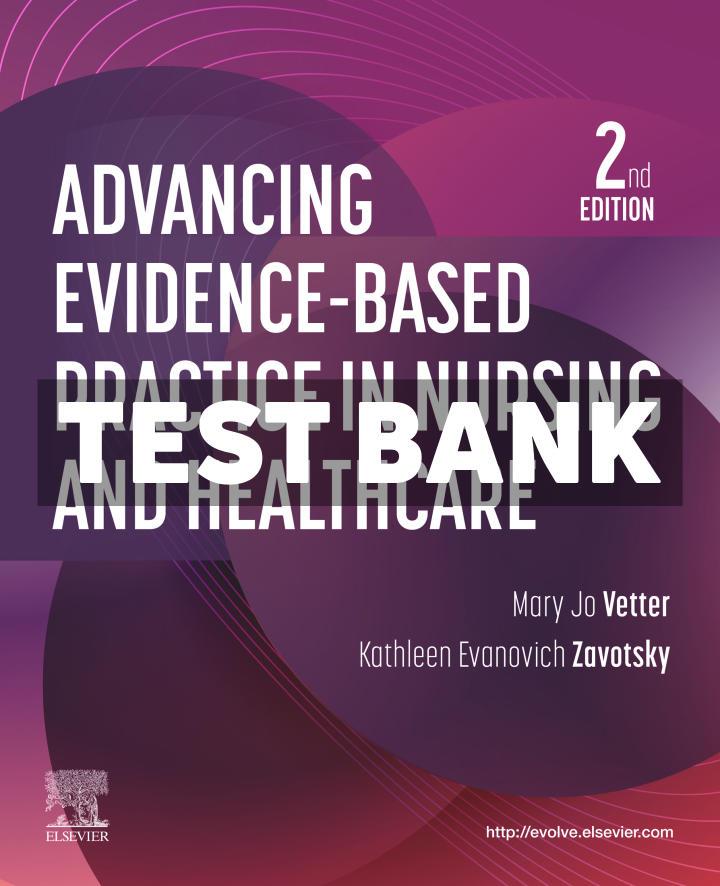

Test Bank - Chapter 01
Q: Which is a good way for a clinical leader to ensure currently practicing nurses have the skills and knowledge necessary to improve patient outcomes?
A. Establish academic-practice partnerships
B. Integrate a process model, such as QSEN (Correct)
C. Take the time to reflect on their work
D. Create an environment for curiosity
Q: Which best exemplifies how nursing leadership can impact nurse wellness?
A. By reducing the need for continuous professional development
B. By ensuring EBP projects are executed successfully (Correct)
C. By limiting the involvement of bedside nurses in policy decision-making
D. By focusing on patient outcomes alone
Q: How can nurse leaders effectively influence education to ensure it reflects current healthcare practices?
A. By focusing on classroom-based learning methods
B. By increasing theoretical knowledge in the curriculum
C. By focusing on nursing, rather than collaboration with other disciplines
D. By integrating specialty training into the curriculum (Correct)
Q: As an advocate-EBP director, which strategy should a nurse leader prioritize to effectively promote evidence-based practice within a healthcare organization?
A. Implement EBP projects then involve multidisciplinary stakeholders for evaluation only
B. Focus on short-term EBP initiatives that can result in quick implementation
C. Ensure that EBP projects are metric-driven and sustainable (Correct)
D. Focus on EBP education for leaders only
Q: Which action should a nurse leader prioritize to sustain evidence-based practice (EBP) for quality-practice within a healthcare organization?
A. Develop and maintain a culture of scientific inquiry (Correct)
B. Focus on individual nurse performance
C. Implement EBP initiatives without adding metrics for patient impact
D. Focus on training newly hired nurses on EBP strategies
Q: A nurse leader aiming to sustain evidence-based practice (EBP) and integrate Quality and Safety Education for Nurses (QSEN) competencies, which prioritize which strategy?
A. Establish a department responsible for the alignment EBP and QSEN initiatives
B. Ensure all nursing staff receive training on EBP and QSEN competencies (Correct)
C. Focus on EBP projects with short-term sustainability first
D. Apply QSEN competencies to mainly high-risk clinical areas
Q: As a nurse leader overseeing Doctor of Nursing Practice (DNP) projects, which approach would best ensure that the project selection supports healthcare system needs?
A. Select projects based on the interests of the DNP student
B. Select projects that fit best in the given timeframe
C. Select projects that have been successful in other organizations
D. Select projects that align with strategic goals of the organization (Correct)
Q: Which strategy may be used to enhance the partnership between academia and practice to support EBP in ambulatory care settings?
A. Conduct joint research projects that address common clinical issues in ambulatory care (Correct)
B. Inviting nurses from the ambulatory care setting to be occasional guest lecturers
C. Focus on theoretical knowledge within the ambulatory care setting
D. Implement standardized protocols from inpatient settings
Q: Which strategy enables a nurse leader to ensure successful implementation of evidence-based practice (EBP) in healthcare setting?
A. Relying on personal expertise and experience to guide EBP projects
B. Delegating EBP-related tasks to junior staff members to build their skills
C. Focusing on short-term goals and immediate outcomes
D. Utilizing a structured model to involve multidisciplinary stakeholders (Correct)
Q: As a nurse with an advanced degree, which action is an example of leveraging scope of influence to enhance patient care and safety?
A. Develop and implement new care protocols independently
B. Collaborate with multidisciplinary teams to improve care delivery (Correct)
C. Ensure frontline staff focus on patient care responsibilities
D. Strictly adhere to existing protocols to ensure safe patient care
Q: Which strategy does not align with the call to action for nurse leaders to promote health equity and nurse wellness?
A. Establish and maintain hierarchy (Correct)
B. Walk the talk
C. Lead with curiosity
D. Know your audience
Q: Which strategy should a nurse leader prioritize to effectively utilize leadership opportunities for advancing evidence-based practice (EBP) in a healthcare setting?
A. Focus on career advancement to improve opportunities to apply EBP
B. Serve as a role model and advocate for rigorous scholarly work (Correct)
C. Delegate leadership responsibilities to frontline staff for training purposes
D. Implement changes based on anecdotal evidence
Q: How can a nurse leader effectively lead with curiosity to enhance evidence-based practice (EBP) in their healthcare team?
A. By discouraging questioning of established practices
B. By implementing changes based on personal experience
C. By fulfilling all needed administrative duties
D. By encouraging team members to participate in continuous learning opportunities (Correct)
Q: Nurse leaders can enhance the effectiveness of evidence-based practice (EBP) implementation by ensuring that the practice environment is inclusive and supports a culture of scientific inquiry.
A. True (Correct)
B. False
Q: A nurse leader functioning as an advocate-EBP director should prioritize exclusively clinical aspects of EBP implementation, leaving the other components to the involvement of the multidisciplinary team.
A. True
B. False (Correct)
Q: To sustain evidence-based practice (EBP) and integrate Quality and Safety Education for Nurses (QSEN) competencies, the nurse leader should prioritize interdisciplinary collaboration and continuous education for all staff.
A. True (Correct)
B. False
Q: A nurse with an advanced degree has a scope of influence that focuses on direct patient care rather than organizational policy and interdisciplinary collaboration.
A. True
B. False (Correct)
Q: A nurse leader’s call to action includes focusing on their own professional development.
A. True
B. False (Correct)
Q: A partnership between practice and academia to support evidence-based practice (EBP) for specialty training ensures that nursing students receive training that is both theoretically sound and practically relevant to current healthcare needs.
A. True (Correct)
B. False
Q: Establishing academic-practice partnerships (APPs) helps ensure that nursing education reflects current healthcare practices and prepares nurses for real-world challenges.
A. True (Correct)
B. False
Q: A key responsibility of DNP leaders in creating the future of healthcare is to avoid direct involvement in clinical practice to focus on high-level administrative and policy-making tasks.
A. True
B. False (Correct)
